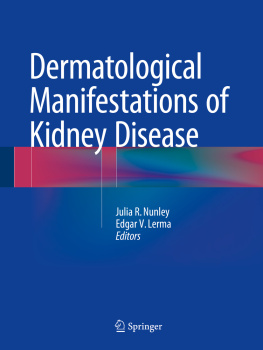KIDNEY DISEASE
KIDNEY
DISEASE

A Guide for Living
WALTER A. HUNT
Foreword by
Ronald D. Perrone, M.D.
Tufts Medical Center

NOTES TO THE READER. This book is not meant to substitute for medical care of people with kidney disease, and treatment should not be based solely on its contents. Instead, treatment must be developed in a dialogue between the individual and his or her physician. Our book has been written to help with that dialogue.
The author and publisher have made reasonable efforts to determine that the selection and dosage of drugs discussed in this text conform to the practices of the general medical community. The medications described do not necessarily have specific approval by the U.S. Food and Drug Administration for use in the diseases and dosages for which they are recommended. In view of ongoing research, changes in governmental regulations, and the constant flow of information relating to drug therapy and drug reactions, the reader is urged to check the package insert of each drug for any change in indications and dosage and for warnings and precautions. This is particularly important when the recommended agent is a new and/or infrequently used drug.
2011 The Johns Hopkins University Press
All rights reserved. Published 2011
Printed in the United States of America on acid-free paper
2 4 6 8 9 7 5 3 1
The Johns Hopkins University
Press 2715 North Charles Street
Baltimore, Maryland 21218-4363
www.press.jhu.edu
Library of Congress Cataloging-in-Publication Data
Hunt, W. A. (Walter A.)
Kidney disease : a guide for living / Walter A. Hunt; foreword by Ronald D. Perrone.
p. cm.
Includes bibliographical references and index.
ISBN-13: 978-0-8018-9963-8 (hardcover : alk. paper)
ISBN-10: 0-8018-9963-X (hardcover : alk. paper)
ISBN-13: 978-0-8018-9964-5 (pbk. : alk. paper)
ISBN-10: 0-8018-9964-8 (pbk. : alk. paper)
1. KidneysDiseasesPopular works. 2. KidneysDiseasesTreatment
Popular works. I. Title.
RC902.H85 2011
616.61dc22 2010025286
A catalog record for this book is available from the British Library.
Figures 2.1, 3.3, 3.4, 3.5, 6.3, 6.4, 6.5, 6.6, 6.7, 6.8, 6.9, 6.10, 6.11, 6.12, 6.13, 6.14, 7.4, and 7.5 are by Jacqueline Schaffer.
Special discounts are available for bulk purchases of this book. For more information,
please contact Special Sales at 410-516-6936 or specialsales@press.jhu.edu.
The Johns Hopkins University Press uses environmentally friendly book materials, including recycled text paper that is composed of at least 30 percent post-consumer waste, whenever possible. All of our book papers are acid-free, and our jackets and covers are printed on
paper with recycled content.
CONTENTS
.
Chapter 1
UNDERSTANDING KIDNEY FAILURE
Chapter 2
WHAT KIDNEYS DO
Chapter 3
WHY KIDNEYS FAIL
Chapter 4
DIAGNOSING AND MANAGING KIDNEY DISEASE
Chapter 5
PREVENTING AND POSTPONING KIDNEY FAILURE
Chapter 6
DIALYSIS
Chapter 7
TRANSPLANTATION
Chapter 8
FUTURE TREATMENT OPTIONS
FOREWORD
It is a pleasure to write this foreword. Very few books like this one are available for people diagnosed with kidney disease. Medical information about kidney disease and kidney failure is abundant, yet important perspectives from patients who have actually experienced kidney disease, kidney failure, and resulting dialysis and transplantation are not easily obtained. Walter Hunt has provided careful and understandable explanations for the layperson, and hes offered his personal experience with and perspectives on how kidney failure has affected his life. I congratulate him for providing this excellent guide for people with kidney disease.
I made the decision to enter the field of nephrology during my second year of medical school while doing a rotation on the inpatient nephrology service. Witnessing the miracle of transplantation and the life-saving treatment of dialysis encouraged me because I recognized that, as a physician, I would have these tools to help patients overcome serious illness. Before these treatments became available, kidney failure was a disease with very limited therapeutic options.
Working with people newly diagnosed with kidney disease and with people who have been living with kidney disease for a long time provides tremendous opportunities to influence their care. When I meet newly diagnosed people, my hope for them is, first, to provide a specific and accurate diagnosis. Then, if a treatment is available, I implement treatment to slow the progress of the disease. It is important to educate patients at this stage, to inform them and their families about the disease, and to enlist the familys participation in the patients care. If necessary, I begin treatment to prevent and manage potential complications and provide reassurance about the options for therapy, including dialysis and transplantation. All of this is not easily accomplished during a single visit! The relationship between patient and doctor is a long-term one with multiple opportunities for my patients to ask questions and to receive information from print or electronic sources to help them understand and manage their disease.
Follow-up visits provide patients and me additional opportunities to go over their care, to discuss how they are doing for their part of the care, and to solidify the bond of comfort and trust that occurs with a long-term doctor-patient relationship. At these visits I often have another opportunity to interact with additional family members as well. Different stages of the disease require different interventions. Long periods of stability are gratifying for everyone involved and dont necessarily require long discussions or any intervention; in contrast, the approach of end-stage renal failure and the need for dialysis or transplant can provoke much anxiety and require frequent visits for education, counseling, and medication adjustment.
Receiving a diagnosis of kidney disease is frightening for nearly everyone. Vivid fears of dialysis and rapid progression to kidney failure are common. More often than not, there are interventions to slow the progression of chronic kidney disease and to manage the complications. Although these interventions are not curesin the way that an antibiotic can cure pneumoniathey can be helpful in preserving health.
I believe it is important for individuals with kidney disease to be fully engaged in the management of their disease. When patients are engaged and involved, its more likely that the progression of the disease will be slowed and complications will be prevented. There are multiple opportunities for patients to improve their long-term outcome. They can become educated about the disease, take appropriate medication and manage their diet, obtain a home blood pressure device and regularly measure and report blood pressure, join patient support groups, and support research and educational efforts by foundations like the National Kidney Foundation and the Polycystic Kidney Disease Foundation.
Dialysis is not a perfect treatment for kidney failure, but, nonetheless, it is life saving and can provide a reasonable quality of life for individuals. Improvements in dialysis technology and the increasing availability of home dialysis and daily dialysis treatments have led to much better outcomes for many individuals. Transplantation, while not a cure for kidney disease, is an excellent treatment, yet it still requires frequent visits to medical providers, lots of pills, and potentially serious complications from these potent medications. Greatly improved quality of life and longer life result from this intervention, but careful compliance and follow-up are necessary.
Next page











